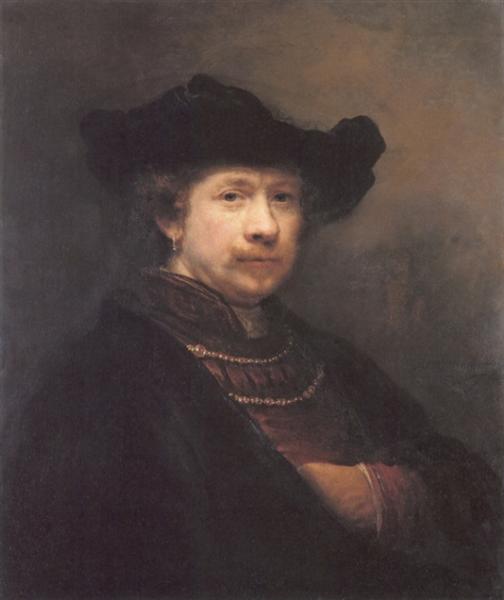Description
Rembrandt van Rijn's painting "Self-Portrait - 1642" reveals a profound knowledge of technique and an extraordinary ability to portray human psychology through light and shadow. The work is a testament to the artist's mastery in the use of chiaroscuro, a distinctive feature of his style that allows for the creation of an intense and dramatic atmosphere. This self-portrait not only captures Rembrandt's physical appearance, but also reveals his emotional state and introspective perspective at a crucial moment in his life.
The composition of the painting frames the artist in a dark space, which makes his illuminated figure stand out. Rembrandt uses a somber background that contrasts with his face and the clothes he wears, an elegant dark suit and a golden gulf that reflects the light in an exceptional way, suggesting both a sense of dignity and a bit of vanity. The way the light caresses his facial features—the prominence of his forehead, the depth of his eyes, and the texture of his skin—conveys a sense of vulnerability and humanity. Rembrandt does not depict himself in an idealized way; instead, he chooses to show his face honestly, with all the wrinkles and marks that time has left on it.
As for the colours, the palette is rich but restrained, dominated by warm, earthy tones that evoke a sense of depth and realism. The smooth transitions between light and shadow, along with the nuances of skin colour that Rembrandt manages to capture, reveal his skilful understanding of anatomy and psychology. The loose brushstroke technique, visible in some areas, adds an almost tactile quality to the painting, inviting the viewer to explore the nuances and textures of the canvas.
This self-portrait is one of a series of self-portraits that Rembrandt painted throughout his life, reflecting his various stages, both artistic and personal. Throughout the 1640s, the artist experiments with his identity, and this work, in particular, resonates with the internal struggle and reflection that characterized him. Through his direct gaze—a combination of defiance and vulnerability—Rembrandt invites the audience into a silent dialogue, bringing to light a personal connection that transcends time.
The sense of intimacy is a defining feature of Rembrandt’s art. In this work, his ability to integrate the emotional with the visual is at its peak, seamlessly uniting his technical mastery with his exploration of the human condition. In a broader context, “Self-Portrait – 1642” can be seen not only as a representation of himself, but as part of a larger tradition within portraiture, where the artist becomes the subject, reflecting the relevance of self-exploration in art.
This self-portrait stands as a key example of Baroque art, with its focus on individuality and drama. Compared to other contemporaries of the time, such as Diego Velázquez, who also made multiple self-portraits, Rembrandt's work stands out for its introspection and transposition of emotional complexity into a simple, yet profound portrait.
"Self-Portrait - 1642" is not only a celebration of Rembrandt's artistic mastery, but also a mirror of his own being, accessible to the contemplation of the observer, who will always find a new angle and a new emotion in his gaze. It is in this place where technique meets introspection, offering an enduring and resonant experience that continues to fascinate those who stop in its presence.
KUADROS ©, a famous painting on your wall.
Hand-made oil painting reproductions, with the quality of professional artists and the distinctive seal of KUADROS ©.
Painting reproduction service with satisfaction guarantee. If you are not completely satisfied with the replica of your painting, we will refund 100% of your money.

